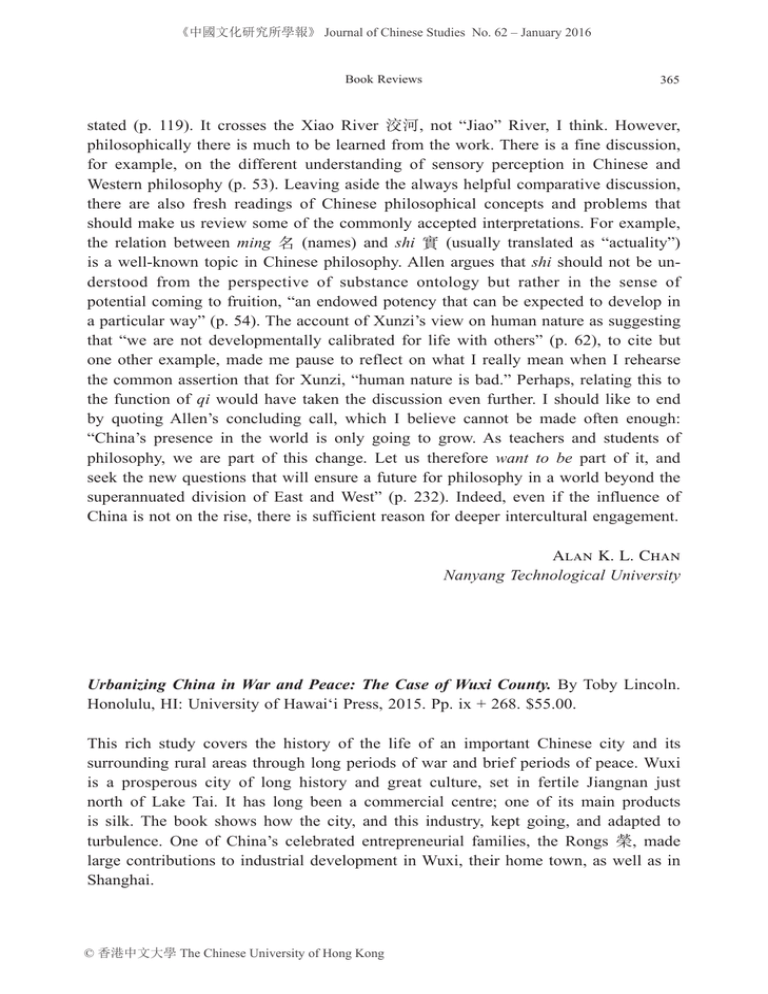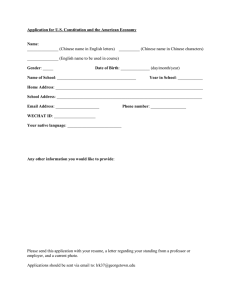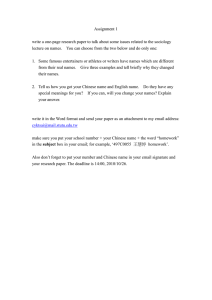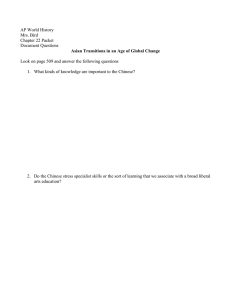stated (p. 119). It crosses the Xiao River 洨河, not “Jiao” River, I think
advertisement

《中國文化研究所學報》 Journal of Chinese Studies No. 62 – January 2016 Book Reviews 365 stated (p. 119). It crosses the Xiao River 洨河, not “Jiao” River, I think. However, philosophically there is much to be learned from the work. There is a fine discussion, for example, on the different understanding of sensory perception in Chinese and Western philosophy (p. 53). Leaving aside the always helpful comparative discussion, there are also fresh readings of Chinese philosophical concepts and problems that should make us review some of the commonly accepted interpretations. For example, the relation between ming 名 (names) and shi 實 (usually translated as “actuality”) is a well-known topic in Chinese philosophy. Allen argues that shi should not be understood from the perspective of substance ontology but rather in the sense of potential coming to fruition, “an endowed potency that can be expected to develop in a particular way” (p. 54). The account of Xunzi’s view on human nature as suggesting that “we are not developmentally calibrated for life with others” (p. 62), to cite but one other example, made me pause to reflect on what I really mean when I rehearse the common assertion that for Xunzi, “human nature is bad.” Perhaps, relating this to the function of qi would have taken the discussion even further. I should like to end by quoting Allen’s concluding call, which I believe cannot be made often enough: “China’s presence in the world is only going to grow. As teachers and students of philosophy, we are part of this change. Let us therefore want to be part of it, and seek the new questions that will ensure a future for philosophy in a world beyond the superannuated division of East and West” (p. 232). Indeed, even if the influence of China is not on the rise, there is sufficient reason for deeper intercultural engagement. Alan K. L. Chan Nanyang Technological University Urbanizing China in War and Peace: The Case of Wuxi County. By Toby Lincoln. Honolulu, HI: University of Hawai‘i Press, 2015. Pp. ix + 268. $55.00. This rich study covers the history of the life of an important Chinese city and its surrounding rural areas through long periods of war and brief periods of peace. Wuxi is a prosperous city of long history and great culture, set in fertile Jiangnan just north of Lake Tai. It has long been a commercial centre; one of its main products is silk. The book shows how the city, and this industry, kept going, and adapted to turbulence. One of China’s celebrated entrepreneurial families, the Rongs 榮, made large contributions to industrial development in Wuxi, their home town, as well as in Shanghai. © 香港中文大學 The Chinese University of Hong Kong 《中國文化研究所學報》 Journal of Chinese Studies No. 62 – January 2016 366 Book Reviews In his account of the city’s urbanization and industrialization Toby Lincoln gives what amounts to a catalogue of the characteristics that have made Chinese entrepreneurs so successful—tenacity, adaptability, endurance, and resilience. These characteristics were on display through the first four decades of the Republic. They were even more in demand after 1949, and in the reform era. There is obviously room for a second volume on Wuxi, to bring its history through the Mao era and in to the present—a promise made in the splendid cover photographs. The modernizing silk industry changed the rural areas around the city as much as it did the city itself. Lincoln describes in detail how the growth of the silk industry incorporated the rural producers of silk worms more and more closely in to the urban industry. This was the same process described in fiction by Mao Dun 茅盾, who came from the same general region of Jiangnan, in his Chun can 春蠶 (Spring Silkworms). Though the peasant producers un that novella were the dupes of the city entrepreneurs, Lincoln’s work focuses on the men who developed the industry and on how they coped with turbulence and uncertainty, including the decline in the popularity of silk amongst foreign consumers after the development of artificial silk. The greatest challenges to Wuxi came in the years of Japanese occupation. Wuxi’s troubles with Chinese warlords and militarists were usually of short duration, and seldom interrupted international trade. The Japanese occupation lasted almost eight years. Foreign trade was at first curtailed then stooped completely. In his efforts to be non-judgemental Lincoln may be too fair-minded in describing the Japanese invasion and occupation. He discusses the chaos it produced, and the great increase in violence in the city and in the countryside that followed. His focus, however, is on how entrepreneurs adapted to occupation, not on the complexity of the times. An example is the dramatic assassination of one of the major collaborators, Yang Shoutong 楊 壽桐, discussed from the point of view of Yang’s family and the collaborationist authorities, not as a political act, though assassination was a serious danger for collaborators in occupied China. A criticism: the maps are inadequate for a study in urban history. They are presented in a schematic way that gives little impression of the layout of the city and its environs. The lack of photographs is a pity. The wonderful cover photos, juxtaposing the Republican and the modern city, show how the process of change could be illustrated. This may be because many academic books are published without illustrations or only with poor quality digital versions. Either way it limits the readers’ feeling for what Wuxi was like at the time. I am looking forward to Lincoln’s further work on this fascinating city, and on the whole tortuous process of urbanization in China. Diana Lary University of British Columbia © 香港中文大學 The Chinese University of Hong Kong




